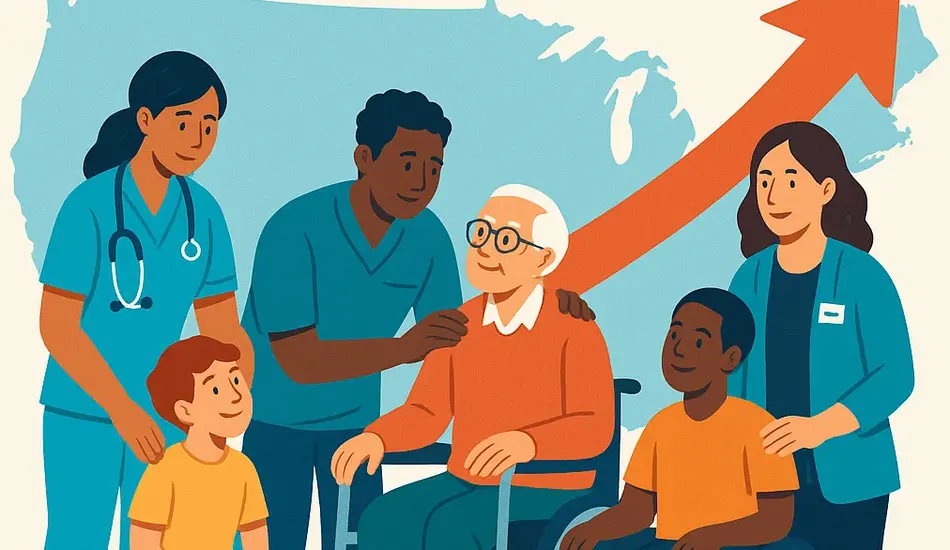America’s care economy is experiencing a significant shift. As the U.S. grapples with an aging population, a post-pandemic mental health crisis, and shifting family dynamics, the social assistance sector is growing at an unprecedented pace.
The social assistance sector once overlooked is now emerging as a cornerstone of the American labor force. This rapidly growing industry includes vital roles such as home health aides, childcare workers, social workers, and mental health counselors. As the social assistance sector expands to meet rising demand, it also faces significant challenges: low wages, burnout, inconsistent training, and unstable funding. Despite these hurdles, the social assistance sector remains crucial to supporting families and communities nationwide. Investing in better conditions and infrastructure for the social assistance sector is essential for sustaining its momentum and impact.
This article examines why the care economy is expanding, where the demand is greatest, and what policymakers, workers, and employers must consider next.
Table of Contents
Employment Is Surging—But So Are the Gaps
The U.S. Bureau of Labor Statistics projects that the social assistance industry will add more than 1.6 million jobs between 2022 and 2032, making it one of the fastest-growing sectors in the country.
Key high-growth occupations include:
- Home Health & Personal Care Aides: +25% growth
- Mental Health and Substance Abuse Counselors: +18%
- Childcare Workers: +14%
- Social Workers (all types): +11%
- Community Health Workers: +16%
Despite being essential to the economy and public health, many of these roles remain among the lowest paid.
💼 Explore Growing Care Work Opportunities on WhatJobs
Looking to make a meaningful career move?
With the surging demand in the social assistance sector, now’s the time to explore careers in healthcare, elder care, social work, and community services.
WhatJobs connects you with roles that make a real impact — in a sector that’s expanding faster than ever
👉 Browse top care and support jobs now — and grow your career with purpose.What’s Fueling the Demand for Care Work?
1. The Aging Population
According to The Administration for Community Living, by 2030, 1 in 5 Americans will be over 65. Seniors increasingly prefer in-home care over nursing facilities, driving demand for trained aides and personal support workers.
2. Behavioral Health Crisis
Mental health support needs are rising among youth and adults. Post-pandemic trauma, economic instability, and a rise in substance use disorders are increasing the workload for counselors, school psychologists, and peer support providers.
The CDC reports that 1 in 3 adults under age 30 now experiences symptoms of anxiety or depression—a significant driver of workforce needs.
3. Disrupted Family Support Systems
With more dual-income households and fewer multigenerational living arrangements, families are outsourcing essential caregiving tasks. Childcare centers, elder care providers, and respite care services are now indispensable in every U.S. metro area.

Where Is the Growth Happening?
Certain states are leading the demand surge due to demographic and policy factors:
- Florida & Arizona – High concentrations of retirees drive demand for in-home and residential care.
- California – Expanding behavioral health funding and early education access are increasing hiring.
- Texas – Growth in Medicaid-supported home and community-based care.
- Midwestern & rural states – Struggling to fill care roles in counties with aging, isolated populations.
The Urban Institute provides data-driven breakdowns by region, illustrating staffing gaps and care shortages.
Who Makes Up the Care Workforce?
According to the Paraprofessional Healthcare Institute (PHI), care workers are overwhelmingly:
- Women (86%)
- People of color (59%)
- Immigrants (25%)
Despite their vital role, these workers frequently earn less than $30,000 per year, often without benefits, career ladders, or workplace protections.
“We are relying on women—especially women of color and immigrants—to do work we undervalue but desperately need,” says Ai-jen Poo, Executive Director of the National Domestic Workers Alliance.
Core Challenges the Sector Faces
1. Low Compensation and High Turnover
Most care roles pay well below national median wages. This leads to chronic staffing shortages, especially in rural and lower-income communities. The average wage for a home care worker in 2024 is just $16.40/hour, per BLS data.
2. Workforce Burnout
Care work is emotionally and physically demanding. Without mental health support, paid leave, or fair scheduling, burnout is rampant.
3. Fragmented Credentialing and Training
Licensing varies by state, and many roles (e.g., elder care assistants) have no formal certification pathway—reducing professional consistency.
Innovations and Investments on the Horizon
Despite obstacles, momentum is building to reform and strengthen the care economy:
Policy Proposals
- The Biden Administration’s 2025 Care Economy Plan includes increased Medicaid reimbursement and childcare tax credits.
- Several states are piloting universal home care or “Care Corps” programs to improve access and job quality.
Workforce Development
- Community colleges and nonprofits are building carework apprenticeships and microcredential pathways.
- Upskilling workers in tech tools (such as remote monitoring or digital charting) boosts efficiency and retention.
Unionization and Organizing
- Groups like SEIU and Caring Across Generations are advocating for wage increases, benefits, and professionalization of care jobs.
Valuing Care: A New Social Contract?
The U.S. care economy is expanding out of necessity—but it also offers an opportunity. Investing in this workforce means improving not just jobs, but lives: for children, the elderly, people with disabilities, and the caregivers themselves.
To meet demand, America must embrace care work as a public good, not just a personal expense. That means higher wages, better training, smarter tech, and stronger policy support.
The question now isn’t whether we need care workers—it’s whether we’re ready to treat them like the essential professionals they are.
FAQs
Q: What jobs are included in the social assistance sector?
A: It includes non-medical support services such as caregiving, mental health aid, childcare, elder care, case management, and social work—delivered through nonprofits, clinics, schools, or private homes.
Q: Are these jobs future-proof?
A: Yes. These roles require emotional intelligence and human interaction—skills that AI and robotics are unlikely to replace.
Q: How can someone enter this field?
A: Many roles only require a high school diploma and on-the-job training. Others—like social workers or licensed counselors—require a degree and certification. Free and low-cost training programs are expanding in many states.
Q: Why is this sector underpaid?
A: Historically, caregiving has been seen as “women’s work” and undervalued. Funding mechanisms (e.g., Medicaid) also cap reimbursement rates for providers.




